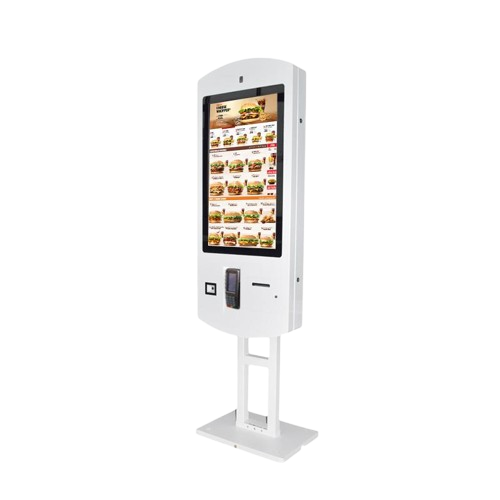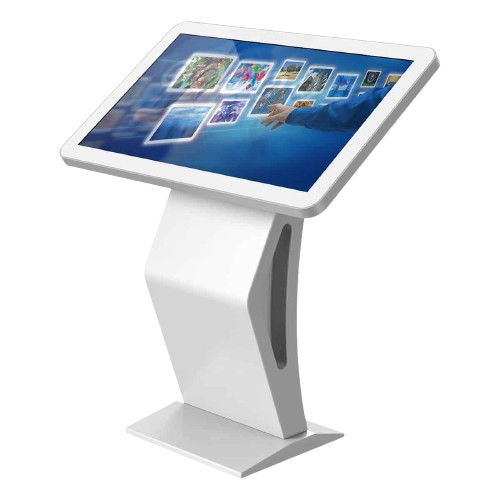Interactive kiosk

by Shivendra
February 14 2024
The Power of Interactive Kiosks: Revolutionizing User Experience
Interactive kiosks have become increasingly popular in various settings, from shopping malls and airports to museums and corporate offices. These digital terminals provide a user-friendly way to access information, services, and more. Let’s explore what interactive kiosks are, how they work, and why they are so beneficial.What is an Interactive Kiosk?
An interactive kiosk is a standalone, self-service digital device that allows users to interact with it through a touch screen or other input methods. These kiosks can be used for a variety of purposes, such as providing information, processing transactions, or offering customer support. They are designed to be intuitive and easy to use, making them accessible for people of all ages and technical abilities.
How Do Interactive Kiosks Work?
Interactive kiosks work by using a combination of hardware and software to provide users with a seamless experience. The hardware typically includes a touch screen, a computer system, and sometimes additional input devices like keyboards or scanners. The software running on the kiosk is designed to guide users through various tasks, whether it’s looking up information, making a purchase, or filling out forms.
When a user approaches the kiosk, they can interact with the touch screen to select options, enter information, or view content. The kiosk processes this input in real-time, providing immediate feedback or results. This makes it a fast and efficient way for users to accomplish their tasks without needing assistance from a person.
Key Benefits of Interactive Kiosks
1. Convenience and Efficiency
Interactive kiosks are all about making life easier. For example, in a shopping mall, a kiosk can help you find stores or check the status of your loyalty points without waiting in line. In airports, these kiosks can streamline check-ins and provide real-time flight information. By allowing users to complete tasks quickly on their own, interactive kiosks help save time and reduce the need for assistance from staff.
2. Cost-Effective Solution
Implementing interactive kiosks can be a cost-effective choice for businesses. While there is an initial investment in the technology, the long-term savings are significant. These kiosks can handle a variety of tasks, reducing the need for additional staff. For instance, a self-service kiosk at a restaurant can take orders and process payments, freeing up staff to focus on food preparation and customer service.
3. Enhanced Customer Experience
Interactive kiosks are designed to be user-friendly. With clear, intuitive touchscreens, users can easily navigate through options and find what they need. In retail, for example, customers can use kiosks to browse product information, check prices, and even place orders. This not only improves the overall shopping experience but also empowers customers by giving them control over their interactions.
4. Personalization and Engagement
Many interactive kiosks can be customized to suit the specific needs of users. For instance, in a hotel lobby, a kiosk might offer guests the option to check in, choose their room preferences, and even view local attractions. This level of personalization makes the experience more engaging and tailored to individual needs. Businesses can also use kiosks to gather feedback, which helps them improve their services based on real customer input.
5. Data Collection and Analytics
Interactive kiosks can provide valuable insights through data collection. By tracking user interactions and preferences, businesses can gain a better understanding of customer behavior. This information can be used to refine marketing strategies, improve service offerings, and make informed business decisions. For example, a retail kiosk might collect data on popular products, helping store managers stock items more effectively.
6. Accessibility and Inclusivity
These kiosks are designed to be accessible to everyone. They often include features like multi-language support and options for users with disabilities, ensuring that a broad range of people can use them comfortably. For instance, a kiosk in a public space might offer screen reader compatibility or provide instructions in multiple languages to cater to diverse user needs.
7. Easy Updates and Maintenance
Updating and maintaining interactive kiosks is straightforward. Many systems allow for remote updates, so businesses can ensure that their kiosks always display the latest information and features without needing physical access. This is particularly useful in high-traffic areas where regular updates are necessary to keep content current and relevant.
Real-World Applications
Interactive kiosks are versatile and can be found in a wide range of settings. Here are a few examples of how they are used:
● Retail Stores-
Customers can use kiosks to check product availability, compare prices, and even make purchases. This helps streamline the shopping process and reduces wait times at checkout counters.
● Airports-
Kiosks facilitate self-check-in, allowing passengers to print boarding passes, check baggage, and get flight updates quickly. This speeds up the airport experience and helps manage large crowds more efficiently.
● Hospitals-
Interactive kiosks in healthcare settings can guide patients through registration, provide information about services, and even direct them to different departments. This improves patient flow and reduces administrative burdens.
● Educational Institutions-
Schools and universities use kiosks for student registration, course selection, and campus information. They help streamline administrative processes and provide students with easy access to important information.
Conclusion
Interactive kiosks are transforming how we interact with technology in various settings. They offer convenience, efficiency, and a personalized experience that benefits both users and businesses. As technology continues to advance, we can expect these kiosks to become even more integrated into our daily lives, making tasks simpler and interactions more engaging. Whether in a retail store, an airport, or a hospital, interactive kiosks are here to stay, driving innovation and enhancing user experiences across the board.




